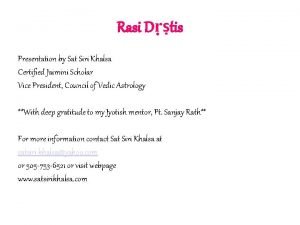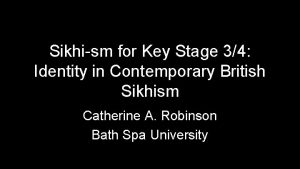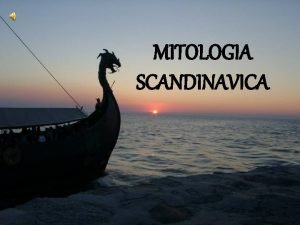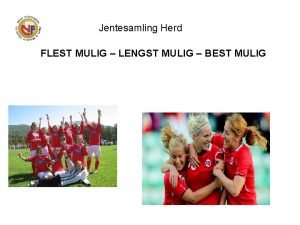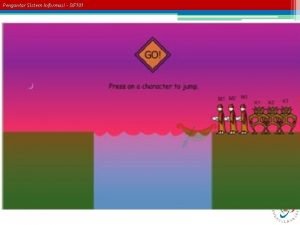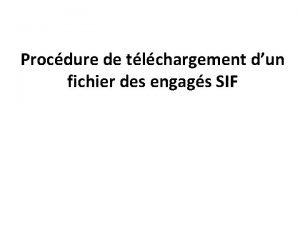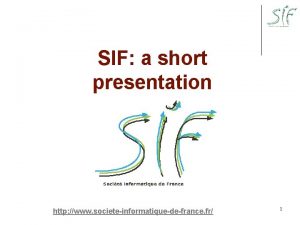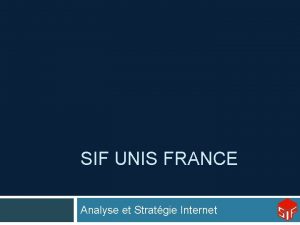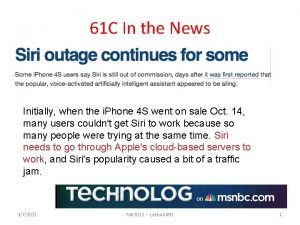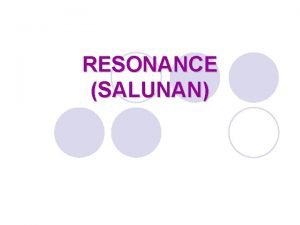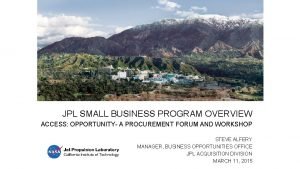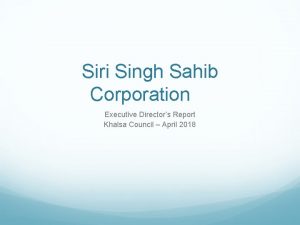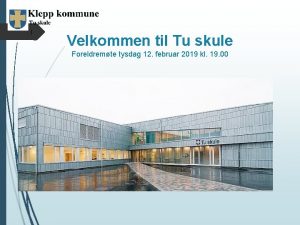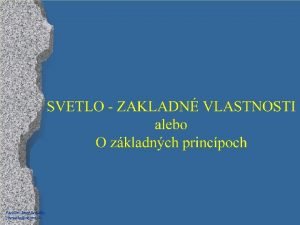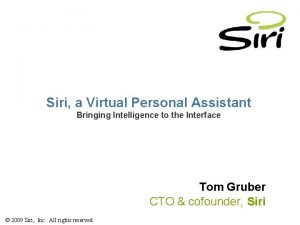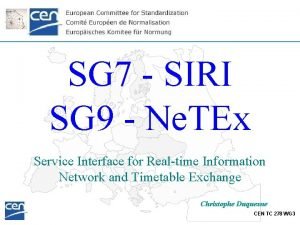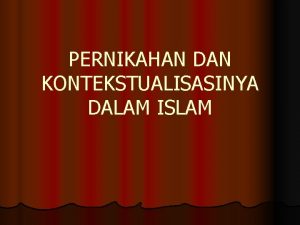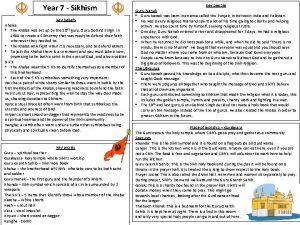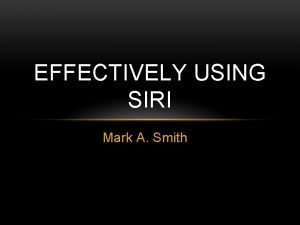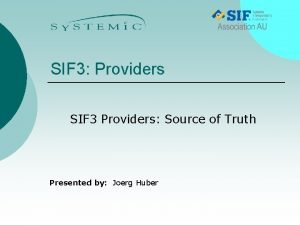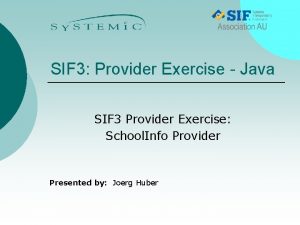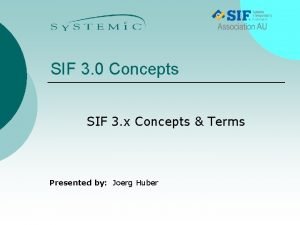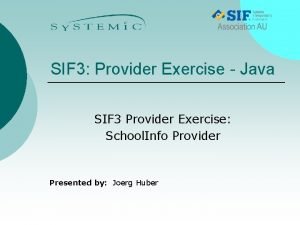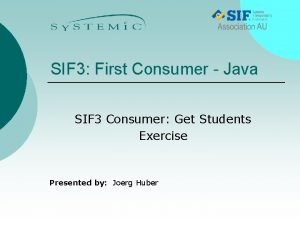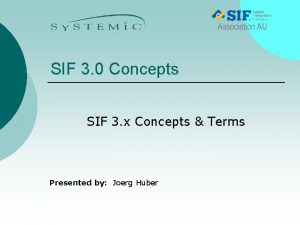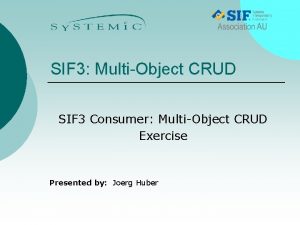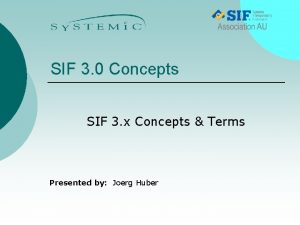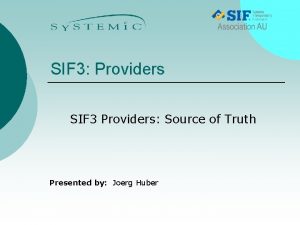SIF Status to ADCWGISS Siri Jodha S Khalsa
















![Interoperability Process 1 New Resource Registration 2 Mediation & access capability [registration] association 3 Interoperability Process 1 New Resource Registration 2 Mediation & access capability [registration] association 3](https://slidetodoc.com/presentation_image_h/f0d9ed1a9581f1043d010de71612a57b/image-17.jpg)



- Slides: 20

SIF Status to ADC/WGISS Siri Jodha S. Khalsa Steve Browdy

SIF Accomplishments • Development and refinement of SIF workflow process. • Identification and deployment of open source workflow system. • Design of experts database and definition of requirements for its linkage to the workflow system. • Accepted request from GEOSec to be GEOSS interoperability “help desk”: – Worked with NASA ECHO services to have them registered properly. – Based upon discussions w/ NASA and GMU, researched and decided on terms for Standards register entry associations, based on eb. RIM. • Formation of Regional Teams. • Design of SIF web presence.

SIF Goals 2009 • Automate workflow system interoperability with registries. • Refine process for review of standards and special interoperability arrangements. – Engage the Regional Teams • Outreach to make GEOSS users and participants more aware of the SIF’s role. – INSPIRE query regarding catalog service descriptions went to AIP • Deploy SIF web presence.

Registry Submission Review Process • Initial Screening – All required fields populated properly • Adherence to GEOSS Interoperability Principles – Standard is non-proprietary; – Standard is “open” meaning is that the specification is accessible by anyone. This does not preclude costs to purchase the standard; – Profiles of the standard are provided where required to make the standard specific enough for implementation; – Standard is well documented; and – Standard has support within at least one user community. • Based on the above, either the item is accepted as submitted or submitter is informed that further work is required

Registry Submission Review Process, p. 2 • Contributes to the overall GEOSS mission? – Suitable for wider use within GEOSS? Would wider adoption present any impediments to GEOSS objectives? – Applicable to communities or SBAs other than those identified? – Should the proposed item be showcased? – Should the contributor be made aware of other/similar standards? – Recommend that Contributor and/or contributor organisation play a bridging function between GEOSS components and Societal Benefit areas (SBAs)? – Inform contributor of complementary organisations wherewith linkages/partnerships may be established? – Relationship to entries in the Service & Component Registry, e. g. is the item referenced by many components and services; are there components and/or services in a similar domain that do not use the item?

Conclusion of Review Process • Outputs of the Review Process: – Recommendation in status change of item, – Feedback to contributor, – A set of proposed actions (to be ratified by SIF), – Recommendations, notifications to GEO Community, – Any additional comments for the attention of the SIF.

SIF Challenges • Getting a broader complement of committed volunteers. • Implementing a rating system for standards and special arrangements – Based on usage to indicate successful interoperability endeavors. • Making SIF the clearinghouse of interoperability issues for GEOSS.

Schedule • November 2008 – SIF workflow system operational – SIF website operational – Refinement of SIF review process • December 2008 – Engage regional teams in SIF tasks • January 2009 – Start of SIF outreach activities • February 2009 – Complete SIF review of existing registry entries • March 2009 – Automate workflow system with Standards Registry • dependent on available resources

IP 3 Status to ADC/WGISS Siri Jodha S. Khalsa Stefano Nativi

Two-way discussion on interoperability in terms of GEOSS’ broad goals and practical aspects and issues exposed in AIP How IP 3 Fits In Help w/ Interoperability Review of Special Arrangements AIP Implementation Experience SIF Mediation Capability Scenarios IP 3 Process Refinement Registries

IP 3 Accomplishments • Analysis of cross-discipline interoperability requirements based on 5 user scenarios • Implementation of a Climate Change Impacts on Biodiversity user scenario offering – An Ecological Niche Modeling server – An Ajax based client to interface the ENM server – Access to Local, Regional and Global climate change datasets (e. g. IPCC and TOPS data) – CSW-based discovery service to GBIF Species Distribution data

IP 3 Goals • Host, register and operate the IP 3 Mediator component for AIP, including: – A community (IP 3) clearinghouse Catalogue Service – Interfaces to numerous disciplinary services based upon interoperability arrangements • The IP 3 Team will participate in interoperability testing of the IP 3 Mediator with other registered components and services to assist in the realization of selected SBA scenarios • Develop and register model interoperability arrangements along with specific mediation solutions, advancing concept of “Model Web. ”

Identifying Unmet Needs • IP 3 will make recommendations where existing standards are not currently meeting the needs of the disciplines including – draft recommendations to appropriate standards developing organizations based upon the GEOSS "Special Arrangements“ and forward to SIF

IP 3 Challenges • Integrating with one or more existing portals • Engage other multidisciplinary science communities – Develop cross-disciplinary use scenarios – Implement mediation services to discover and access resources based on special arrangements • Experiment process interoperability – Workflow for scientific resources registering, discovery and access • Experiment model servers interoperability – Workflow for registering, discovering and accessing model components

Schedule • November 2008 – New cross-disciplinary use scenarios are designed – New Model resources to be registered and interfaced are recognized • February 2009 – IP 3 Clearinghouse/Mediator fully operational – Demonstration of the new cross-disciplinary use scenarios – Demonstration of the new model servers usage – Process interoperability workflow for Scientific resources is described and demonstrated. This is provided as a contribution to the GCI. • June 2009 – Additional cross-disciplinary use scenarios and mediation services

Thank You!
![Interoperability Process 1 New Resource Registration 2 Mediation access capability registration association 3 Interoperability Process 1 New Resource Registration 2 Mediation & access capability [registration] association 3](https://slidetodoc.com/presentation_image_h/f0d9ed1a9581f1043d010de71612a57b/image-17.jpg)
Interoperability Process 1 New Resource Registration 2 Mediation & access capability [registration] association 3 Discovery & Query Distribution capabilities enablement Earth System Science Community Component Registry Information Communities PROCESS Service Registry International Standard / Special Interoperability Arrangement Registry Distributed catalog

Model Interoperabililty • Simulation models are generally built in isolation and do not easily interoperate with others • Result: lost opportunities to address important questions • Barriers to interoperability are both technical and cultural • For IP 3 we will EGU GA 4/08 # 18

• Improve The Modelmodels Web initiative existing or • Create new models or • Increase model Model A Model G Model B Dataset 1 Model C Dataset 3 interoperability Model D Dataset 2 Model F Dataset 4 Model E Model Web April 2008 Gary Geller NASA JPL California Institute of Technology

• knowledge is as heterogeneous as human beings; thus, "mediation" is the only way to address such domain. The technocratic approach to generate a world of "standard" components which fit in perfectly seems to be utopist and limiting.
 Siri rasi
Siri rasi Tat khalsa
Tat khalsa Khalsa means
Khalsa means Waheguru ji ka khalsa
Waheguru ji ka khalsa Zeul intunericului
Zeul intunericului Sif kalvø
Sif kalvø Sif
Sif Ffe club sif bo
Ffe club sif bo Sif informatique
Sif informatique Sif unis france
Sif unis france No vuela y tiene ala no es camión y hace cran
No vuela y tiene ala no es camión y hace cran Siri what time is it
Siri what time is it Apa itu rlc
Apa itu rlc Jpl siri
Jpl siri Siri what should i eat
Siri what should i eat Siri singh sahib corporation
Siri singh sahib corporation Siri nessa bjørnevik
Siri nessa bjørnevik V rovnorodom prostredí sa svetlo šíri
V rovnorodom prostredí sa svetlo šíri Siri dahl personal assistant
Siri dahl personal assistant Siri what time is it
Siri what time is it Nikah siri dalam islam
Nikah siri dalam islam
